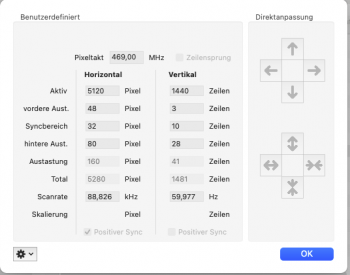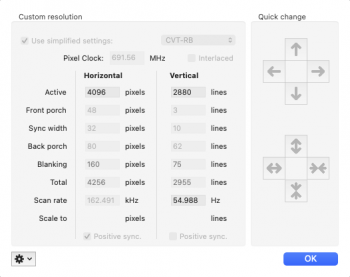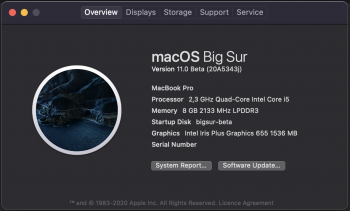I am looking for confirmation of the following result:
I believe Apple has enabled support for displays that are wider than 4096 pixels (at least up to 5120) on some Intel GPUs in Big Sur (Windows and Linux have supported this for awhile). One person reported success with Kaby Lake graphics.
Update: Others have reported success with Coffee Lake graphics. Looking at the code, it appears that only Kaby Lake and Coffee Lake were updated to support 5K SST.
I did not get the same result with my Mac mini 2018 (newer Coffee Lake graphics).
Update: This is because my display is 4K - you need a display that has a timing in the EDID with width > 4096 to allow 5K SST.
I am referring to single cable displays (which use one DisplayPort signal), not dual link SST displays like the LG UltraFine 5K display (which use two DisplayPort signals - 2560x2880 each).
For confirmation evidence, we need timing info from SwitchResX showing pixel clock and active pixels of 5120 or a photo of the onscreen menu of the display showing 5120 width.
How wide of a resolution (a normal timing, not a scaled resolution) can you make in SwitchResX? 8192?
Below is a list of max pixel clocks for DisplayPort 1.2. Some pixel formats are not supported by Intel or macOS or both. macOS does not have a method exposed to the user to change the output pixel format (except the new "High Dynamic Range" option - 10bpc is required for HDR). SwitchResX has options to change the frame buffer pixel depth between Millions and Billions of colors but this does not necessarily affect the output pixel format. You can see the output pixel format using the AGDCDiagnose command (but only for AMD graphics).
Some PC 4K displays like the Acer XV273K can accept higher width timings like 5120x2880 - so it's a good display to test with if you don't have one of the widescreen displays. Even if your display does not support width > 4096, it will be helpful to know whether macOS will accept a custom timing with width > 4096. Create the timing with SwitchResX, Command-S to save to override file, then click "Activate immediately", then check the list of Current Resolutions to see if it was added, and check Custom Resolutions to see if it was activated - you may need to turn off the display, then turn it on for detection to work, or disconnect/reconnect the display.
Update: Actually, you need a display that has a timing in the EDID with width > 4096. A patch is in progress to enable 5K SST with displays that don't have a timing in the EDID with width > 4096.
Update: The patch is complete and exists in my fork of Lilu and WhateverGreen. If you use any other Lilu dependant kexts then you'll need to recompile them using my Lilu.
I think currently SwitchResX overrides do not survive reboot in Big Sur. If so, then they at least remain in SwitchResX preferences so you can Save (Command-S) and "Activate immediately" after a reboot. Rebooting shouldn't be necessary to activate a custom timing. You may need to disconnect and reconnect the display for SwitchResX to update properly.
Ice Lake is known to support DisplayPort 1.4, so it probably has no problem, even in Catalina.
AMD GPUs should have no problem supporting resolutions with widths greater than 4096, except older AMD GPUs produce garbled pixels in that case. I don't know if Big Sur will fix those.
https://egpu.io/forums/bootcamp/mid-2015-15-inch-macbook-pro-egpu-master-thread/paged/10/#post-84794
Examples of older AMD GPUs that have a problem:
Intel Graphics Drivers
Tests (assume native timing of display or CVT-RB for custom timings):
=
=
Information to collect:
Also include Model as it appears in "About This Mac", for example: Mac mini (2018)
I believe Apple has enabled support for displays that are wider than 4096 pixels (at least up to 5120) on some Intel GPUs in Big Sur (Windows and Linux have supported this for awhile). One person reported success with Kaby Lake graphics.
Update: Others have reported success with Coffee Lake graphics. Looking at the code, it appears that only Kaby Lake and Coffee Lake were updated to support 5K SST.
I did not get the same result with my Mac mini 2018 (newer Coffee Lake graphics).
Update: This is because my display is 4K - you need a display that has a timing in the EDID with width > 4096 to allow 5K SST.
I am referring to single cable displays (which use one DisplayPort signal), not dual link SST displays like the LG UltraFine 5K display (which use two DisplayPort signals - 2560x2880 each).
For confirmation evidence, we need timing info from SwitchResX showing pixel clock and active pixels of 5120 or a photo of the onscreen menu of the display showing 5120 width.
How wide of a resolution (a normal timing, not a scaled resolution) can you make in SwitchResX? 8192?
Below is a list of max pixel clocks for DisplayPort 1.2. Some pixel formats are not supported by Intel or macOS or both. macOS does not have a method exposed to the user to change the output pixel format (except the new "High Dynamic Range" option - 10bpc is required for HDR). SwitchResX has options to change the frame buffer pixel depth between Millions and Billions of colors but this does not necessarily affect the output pixel format. You can see the output pixel format using the AGDCDiagnose command (but only for AMD graphics).
| Pixel Clock | Pixel Formats |
| 576 MHz | 10bpc RGB |
| 720 MHz | 12bpc YCbCr 4:2:2, 8bpc RGB |
| 864 MHz | 10bpc YCbCr 4:2:2 |
| 960 MHz | 12bpc YCbCr 4:2:0, 6bpc RGB |
| 1080 MHz | 8bpc YCbCr 4:2:2 |
| 1152 MHz | 10bpc YCbCr 4:2:0 |
| 1440 MHz | 8bpc YCbCr 4:2:0 |
Some PC 4K displays like the Acer XV273K can accept higher width timings like 5120x2880 - so it's a good display to test with if you don't have one of the widescreen displays. Even if your display does not support width > 4096, it will be helpful to know whether macOS will accept a custom timing with width > 4096. Create the timing with SwitchResX, Command-S to save to override file, then click "Activate immediately", then check the list of Current Resolutions to see if it was added, and check Custom Resolutions to see if it was activated - you may need to turn off the display, then turn it on for detection to work, or disconnect/reconnect the display.
Update: Actually, you need a display that has a timing in the EDID with width > 4096. A patch is in progress to enable 5K SST with displays that don't have a timing in the EDID with width > 4096.
Update: The patch is complete and exists in my fork of Lilu and WhateverGreen. If you use any other Lilu dependant kexts then you'll need to recompile them using my Lilu.
I think currently SwitchResX overrides do not survive reboot in Big Sur. If so, then they at least remain in SwitchResX preferences so you can Save (Command-S) and "Activate immediately" after a reboot. Rebooting shouldn't be necessary to activate a custom timing. You may need to disconnect and reconnect the display for SwitchResX to update properly.
Ice Lake is known to support DisplayPort 1.4, so it probably has no problem, even in Catalina.
AMD GPUs should have no problem supporting resolutions with widths greater than 4096, except older AMD GPUs produce garbled pixels in that case. I don't know if Big Sur will fix those.
https://egpu.io/forums/bootcamp/mid-2015-15-inch-macbook-pro-egpu-master-thread/paged/10/#post-84794
Examples of older AMD GPUs that have a problem:
- MacBook Pro (Retina, 15-inch, Mid 2015), AMD Radeon R9 M370X
- Mac Pro (Late 2013), AMD AMD FirePro D300, AMD FirePro D500, AMD FirePro D700
Intel Graphics Drivers
| (Gen11) Ice Lake | (Gen9) Coffee Lake | (Gen9) Kaby Lake | (Gen9) Skylake | (Gen8) Broadwell | (Gen7) Haswell | (Gen7) Ivy Bridge |
| AppleIntelICLGraphics.kext AppleIntelICLLPGraphicsFramebuffer.kext AppleIntelICLGraphicsGLDriver.bundle AppleIntelICLGraphicsMTLDriver.bundle AppleIntelICLGraphicsVADriver.bundle AppleIntelICLLPGraphicsVAME.bundle | _ AppleIntelCFLGraphicsFramebuffer.kext _ _ _ AppleIntelCFLGraphicsVAME.bundle | AppleIntelKBLGraphics.kext AppleIntelKBLGraphicsFramebuffer.kext AppleIntelKBLGraphicsGLDriver.bundle AppleIntelKBLGraphicsMTLDriver.bundle AppleIntelKBLGraphicsVADriver.bundle AppleIntelKBLGraphicsVAME.bundle | AppleIntelSKLGraphics.kext AppleIntelSKLGraphicsFramebuffer.kext AppleIntelSKLGraphicsGLDriver.bundle AppleIntelSKLGraphicsMTLDriver.bundle AppleIntelSKLGraphicsVADriver.bundle AppleIntelSKLGraphicsVAME.bundle | AppleIntelBDWGraphics.kext AppleIntelBDWGraphicsFramebuffer.kext AppleIntelBDWGraphicsGLDriver.bundle AppleIntelBDWGraphicsMTLDriver.bundle AppleIntelBDWGraphicsVADriver.bundle AppleIntelBDWGraphicsVAME.bundle | AppleIntelHD5000Graphics.kext AppleIntelFramebufferAzul.kext AppleIntelHD5000GraphicsGLDriver.bundle AppleIntelHD5000GraphicsMTLDriver.bundle AppleIntelHD5000GraphicsVADriver.bundle _ | AppleIntelHD4000Graphics.kext AppleIntelFramebufferCapri.kext AppleIntelHD4000GraphicsGLDriver.bundle AppleIntelHD4000GraphicsMTLDriver.bundle AppleIntelHD4000GraphicsVADriver.bundle _ |
Tests (assume native timing of display or CVT-RB for custom timings):
=
| Mac Model | CPU, Graphics | Graphics Driver | Max | Evidence | Notes |
| ================== | ================== | ============================== | ============= | ============== | ========================= |
| MacBook Air (Retina, 13-inch, 2018) | 1.6 GHz Dual-Core Core i5 Intel UHD Graphics 617 1536 MB | AppleIntelKBLGraphicsFramebuffer (16.0.0) AppleIntelKBLGraphics(16.0.0) macOS 11.0 (20A4299v, 20A4300b) | 5120x1440@60Hz |  | Dell U4919DW discussions.apple.com |
| MacBook Pro (13-inch, 2019, Four Thunderbolt 3 ports) | Intel Iris Plus Graphics 655 | AppleIntelCFLGraphicsFramebuffer (16.0.0) AppleIntelKBLGraphics(16.0.0) ig-platform-id: 0x3ea50004 | 5120x1440@60Hz | Phillips 499P9H www.reddit.com | |
| MacBook Pro (13-inch, 2018, Four Thunderbolt 3 ports) | 2.3 GHz Quad-Core Core i5 Intel Iris Plus Graphics 655 1536 MB | macOS 11.0 (20A5343j) | 5120x1440@60Hz | Samsung 49" CRG9 discussions.apple.com LG 49WL95C #18 | |
| MacBook Pro (13-inch, 2017, Two Thunderbolt 3 ports) MacBookPro14,1 Mac-B4831CEBD52A0C4C | 2.5 GHz Dual-Core Core i5 Intel Iris Plus Graphics 640 1536 MB | AppleIntelKBLGraphicsFramebuffer (16.0.0) AppleIntelKBLGraphics (16.0.0) macOS 11.0 (20A5343j) ig-platform-id: 0x59260002 | 5120x1440@70Hz | Phillips 499P9H EDID: PHL 499P9 #26 | |
| MacBook Pro (13-inch, 2016, Four Thunderbolt 3 ports) | Intel Iris Graphics 550 | untested | |||
| MacBook Pro (13-inch, 2016, Two Thunderbolt 3 ports) | Intel Iris Graphics 540 1536 MB | AppleIntelSKLGraphicsFramebuffer (16.0.0) AppleIntelSKLGraphics (16.0.0) Big Sur Beta 2, Beta 3, Beta 4 ig-platform-id: 0x19260002 | 3840x1080@60Hz | Dell U4919DW #5 LG 49 #13, #17 | |
| Mac mini (2018) Macmini8,1 Mac-7BA5B2DFE22DDD8C | 3.2 GHz 6-Core Core i7 Intel UHD Graphics 630 1536 MB | AppleIntelCFLGraphicsFramebuffer (16.0.0) AppleIntelKBLGraphics (16.0.0) macOS 11.0 (20A5323j) ig-platform-id: 0x3e900007 | 5120x1440@70Hz | Phillips 499P9H EDID: PHL 499P9 #24, #27 | |
| Mac mini (2018) Macmini8,1 Mac-7BA5B2DFE22DDD8C | 3.6 GHz Quad-Core Core i3 Intel UHD Graphics 630 1536 MB | AppleIntelCFLGraphicsFramebuffer (16.0.0) AppleIntelKBLGraphics (16.0.0) macOS 11.0 (20A4299v, 20A4300b, 20A5323i) ig-platform-id: 0x3e9b0007 | macOS: 4096x2880@57Hz Windows: 5120x1440@60Hz (did not try 5Kx2880) |    | Acer XV273K Max height of 2880 can probably be patched. The driver accepts the timing but the GPU produces black screen until 55Hz. Supports 5120x2880 with AMD eGPU. Supports 5120x1440 with iGPU in Windows 10. Update: 5K will work with a display that is actually 5K width. A patch is in progress to enable 5K SST with smaller displays. |
Information to collect:
Code:
kextstat | grep Intel | egrep "Graphics|Framebuffer"
ioreg -lw0 | grep "AAPL,ig-platform-id"
ioreg -lw0 | grep '<"Mac'
system_profiler SPHardwareDataType SPDisplaysDataType | sed '/.*Serial.*/d;/.*UUID.*/d'
system_profiler SPSoftwareDataType | grep System
Last edited:





